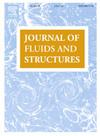Assessment of regular and earthquake-induced wave hydrodynamic tests of moored and end-fixed submerged floating tunnels
IF 3.4
2区 工程技术
Q1 ENGINEERING, MECHANICAL
引用次数: 0
Abstract
Submerged floating tunnel (SFT) is a new type of fully immersed sea-crossing structure for future traffic design, which has a high application prospect in complex bay environment. During the service lifespan, SFTs have the risk of wave impact. Therefore, to ensure safety and stability of the SFTs, hydrodynamic tests of a 1:60 scaled model were carried out in a large pool with underwater vibration table, where data on acceleration, roll, pitch rotation, yaw rotation, displacement, variation table and cable tension were collected. Comprehensive investigation was conducted to explore the excitation effects and hydroelastic responses of the model under regular and earthquake-induced waves with different immersion depths along with the modal characteristic analysis. The results show that the natural frequency of the SFT is significantly influenced by the angle of the cables. As the angle increases, the vertical stiffness of the system also increases, which consequently raises the natural frequency of the structure. According to hydrodynamic analysis, shallower the depth of the SFT, the more it hinders the propagation of waves, resulting in subsequent wave attenuation but aggravating structural responses. Furthermore, under regular and earthquake-induced waves, harmonic resonance can be triggered. The acceleration, roll angle, and cable tension undergo the most significant changes at the mid-span section. The increase in cable tension on the upstream side exceeds the decrease in tension under higher frequency wave due to wave impact force. There are discrepancies in angle responses among the cross-sections and the mid-span section demonstrates larger roll angles and smaller pitch and yaw angles, leading to phase angle deviations among the three variations. For earthquake-induced waves, more pronounced structural responses result from greater seismic acceleration amplitude and shallower immersion depth. And the response relationship between sway and heave, as well as the periodic variations in mooring cable tension and angle, remains consistent with that under regular waves. This consistency underscores that the dynamic behavior of the SFT is primarily governed by the intrinsic structural properties and hydrodynamic interactions, rather than the specific nature of the wave excitation.
系泊与端部固定沉水浮式隧道规则波与震源波水动力试验评价
沉浮隧道是一种面向未来交通设计的新型全沉式跨海结构,在复杂的海湾环境中具有很高的应用前景。在使用寿命期间,SFTs存在波浪冲击的风险。因此,为了保证SFTs的安全性和稳定性,我们在一个大型水池中进行了1:60比例模型的水动力试验,并设置了水下振动台,收集了加速度、横摇、俯仰旋转、偏航旋转、位移、变化表和索张力等数据。全面考察了该模型在不同浸没深度的规则波和地震诱发波作用下的激励效应和水弹性响应,并进行了模态特性分析。结果表明,斜拉索角度对斜拉索结构的固有频率有显著影响。随着角度的增加,系统的垂直刚度也增加,从而提高了结构的固有频率。水动力分析表明,SFT深度越浅,对波浪传播的阻碍越大,导致后续波浪衰减,但加剧了结构响应。此外,在规则波和地震诱发波下,可以触发谐波共振。加速度、横摇角和索张力在跨中截面变化最为显著。在高频波作用下,由于波浪冲击力的作用,索上游侧张力的增加超过了张力的减少。不同截面的角度响应存在差异,跨中截面的横摇角较大,俯仰角和偏航角较小,导致三者之间的相位角存在差异。对于地震诱发波,更大的地震加速度幅值和更浅的浸没深度导致更明显的结构响应。在规则波作用下,锚泊索的横摇和升沉响应关系以及锚泊索张力和角度的周期性变化与规则波作用下的响应关系基本一致。这种一致性强调了SFT的动力行为主要是由固有的结构特性和水动力相互作用决定的,而不是由波激励的特定性质决定的。
本文章由计算机程序翻译,如有差异,请以英文原文为准。
求助全文
约1分钟内获得全文
求助全文
来源期刊

Journal of Fluids and Structures
工程技术-工程:机械
CiteScore
6.90
自引率
8.30%
发文量
173
审稿时长
65 days
期刊介绍:
The Journal of Fluids and Structures serves as a focal point and a forum for the exchange of ideas, for the many kinds of specialists and practitioners concerned with fluid–structure interactions and the dynamics of systems related thereto, in any field. One of its aims is to foster the cross–fertilization of ideas, methods and techniques in the various disciplines involved.
The journal publishes papers that present original and significant contributions on all aspects of the mechanical interactions between fluids and solids, regardless of scale.
 求助内容:
求助内容: 应助结果提醒方式:
应助结果提醒方式:


